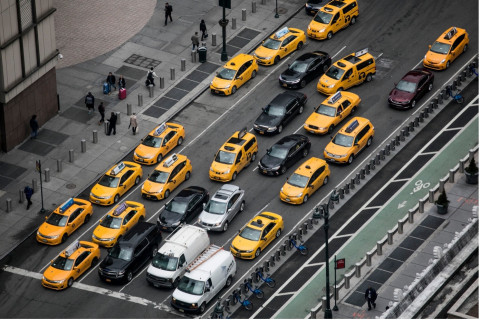If autonomous cars can transport us affordably, do we no longer want to own our own car? Are we switching en masse from public transport, do we leave our bikes unused, or do we walk less? Do we drive alone, or do we share the car with other passengers? Will autonomous cars share he road with other traffic, including cycling? Are we going to use a car more often and longer and how many cars drive empty waiting for a customer?
Of course, no scientific study can answer all these questions yet. Nevertheless, research offers some insight.
Ride-hailing
First, what do we know about the influence of ride-hailing? That is calling a taxi from Uber or Lyft and a handful of other companies with an app. Juniper Research expects that the use of this service, which already has a global turnover of $ 147 billion, will increase fivefold in the coming five years, regardless of whether the taxis involved are 'self -driving' or not. Clear is that most users seem not to appreciate the presence of fellow passengers: the number of travelers that share journeys is only 13%.
Research in seven major American cities shows that 49 to 61 percent of all Uber and Lyft-taxi rides would have been made by walking, cycling, taking public transport or not at all. These journeys only replace car use to a limited extent. As a result, the number of train passengers has already fallen by 1.3% per year and that by bus by 1.7%. At the same time, congestion has increased.
A publication in the Journal Transport policy showed that travelers travel twice as many kilometers in every American region that they would have done if Uber and Lyft did not exist. It also turned out that taxis drive empty 50% of the time while they are waiting for or on their way to a new customer. Another study found that many Uber and Lyft customers who once used public transport buy a car for themselves.
The effect of 'self -driving' cars
The number of studies after the (possible) effect of the arrival of 'self -driving' cars is increasing rapidly. Research by the Boston Consultancy Group showed that 30% of all journeys will take place in a 'self -driving' car as soon as they are available. A considerable number of former public transport users says they will change. Despite the price advantage, the respondents will make little use of the option to share a car with other passengers, but it is known that attitudes and related behavior often differ. Nevertheless, this data has been used to calculate that there will be more cars on the road in large parts of the cities, resulting in more traffic jams.
Semi-experimental research also showed that the ability to travel with a 'self-driving' car results in an increase in the number of kilometers covered by around 60%. Unless autonomous cars drive electrically, this will also have significant negative consequences for the environment.
The Robottaxis in suburbs had a different effect: here travelers would leave their car at home more often and use the taxi to be transported to a station.
See robot taxis and public transport in combination
Despite all the reservations that must be made with this type of research, all results indicate a significant increase in the use of taxis, which will be at the expense of public transport and will result in more traffic jams in urbanized areas. This growth can be reversed by making shared transport more attractive. Especially on the routes to and from train, metro, and bus stations. Only in that case, will there be an ideal transport model for the future: large-scale and fast public transport on the main roads and small-scale public transport for the last kilometers and in rural areas.
In a couple of days my new ebook will be available. It is a collection of the 25 recommendations for better streets, neighbourhoods and city's that have been published at this spot during the last months





